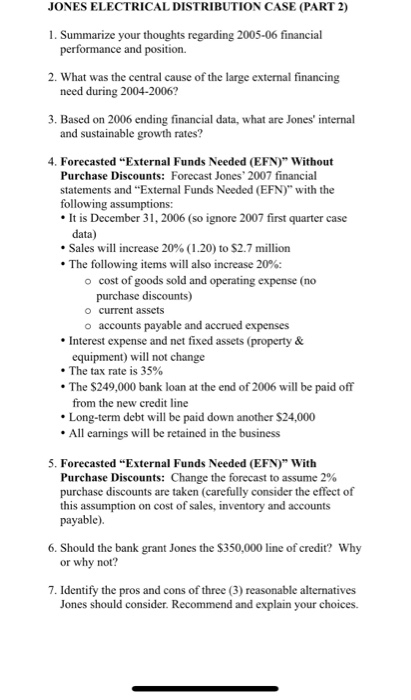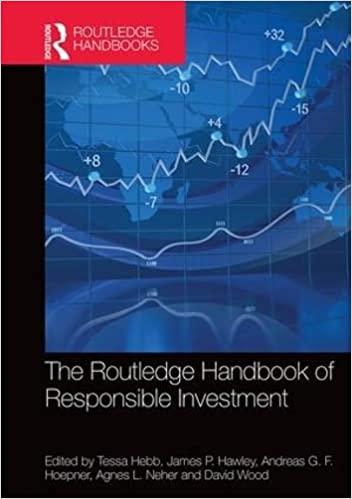jones electrical distribution case study

JONES ELECTRICAL DISTRIBUTION CASE (PART 2) 1. Summarize your thoughts regarding 2005-06 financial performance and position. 2. What was the central cause of the large external financing need during 2004-2006? 3. Based on 2006 ending financial data, what are Jones' internal and sustainable growth rates? 4. Forecasted "External Funds Needed (EFN)" Without Purchase Discounts: Forecast Jones' 2007 financial statements and "External Funds Needed (EFN)" with the following assumptions: It is December 31, 2006 (so ignore 2007 first quarter case data) Sales will increase 20% (1.20) to $2.7 million The following items will also increase 20%: o cost of goods sold and operating expense (no purchase discounts) o current assets o accounts payable and accrued expenses Interest expense and net fixed assets (property & equipment) will not change The tax rate is 35% The $249,000 bank loan at the end of 2006 will be paid off from the new credit line Long-term debt will be paid down another $24,000 All earnings will be retained in the business 5. Forecasted "External Funds Needed (EFN)" With Purchase Discounts: Change the forecast to assume 2% purchase discounts are taken (carefully consider the effect of this assumption on cost of sales, inventory and accounts payable) 6. Should the bank grant Jones the $350,000 line of credit? Why or why not? 7. Identify the pros and cons of three (3) reasonable alternatives Jones should consider. Recommend and explain your choices. JONES ELECTRICAL DISTRIBUTION CASE (PART 2) 1. Summarize your thoughts regarding 2005-06 financial performance and position. 2. What was the central cause of the large external financing need during 2004-2006? 3. Based on 2006 ending financial data, what are Jones' internal and sustainable growth rates? 4. Forecasted "External Funds Needed (EFN)" Without Purchase Discounts: Forecast Jones' 2007 financial statements and "External Funds Needed (EFN)" with the following assumptions: It is December 31, 2006 (so ignore 2007 first quarter case data) Sales will increase 20% (1.20) to $2.7 million The following items will also increase 20%: o cost of goods sold and operating expense (no purchase discounts) o current assets o accounts payable and accrued expenses Interest expense and net fixed assets (property & equipment) will not change The tax rate is 35% The $249,000 bank loan at the end of 2006 will be paid off from the new credit line Long-term debt will be paid down another $24,000 All earnings will be retained in the business 5. Forecasted "External Funds Needed (EFN)" With Purchase Discounts: Change the forecast to assume 2% purchase discounts are taken (carefully consider the effect of this assumption on cost of sales, inventory and accounts payable) 6. Should the bank grant Jones the $350,000 line of credit? Why or why not? 7. Identify the pros and cons of three (3) reasonable alternatives Jones should consider. Recommend and explain your choices







